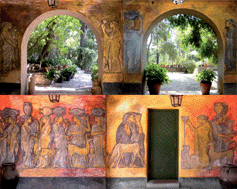Characterization of the binding medium used in Roman encaustic paintings on wall and wood†
Abstract
The characterization by means of

* Corresponding authors
a
Encáustica Cuní S.L., Pza. Conde Valle Suchil, 3, 28015 Madrid, Spain
E-mail:
jcuni@encausticcuni.com
Tel: +34 914 353 344
b
Test Lab. Encáustica Cuní S.L., 834 Riverside Drive Apt. 6D, New York, NY 10032, USA
E-mail:
pcuni@encausticcuni.com
Tel: +1 212 568 1778
c
Department of Chemistry, The Cooper Union for the Advancement of Science and Art, 41 Cooper Square, New York, NY 10003, USA
E-mail:
eisen@cooper.edu, rsavizky@cooper.edu, bove@cooper.edu
Fax: +1 212 353 4341
Tel: +1 212 353 4372
The characterization by means of

 Please wait while we load your content...
Something went wrong. Try again?
Please wait while we load your content...
Something went wrong. Try again?
J. Cuní, P. Cuní, B. Eisen, R. Savizky and J. Bové, Anal. Methods, 2012, 4, 659 DOI: 10.1039/C2AY05635F
To request permission to reproduce material from this article, please go to the Copyright Clearance Center request page.
If you are an author contributing to an RSC publication, you do not need to request permission provided correct acknowledgement is given.
If you are the author of this article, you do not need to request permission to reproduce figures and diagrams provided correct acknowledgement is given. If you want to reproduce the whole article in a third-party publication (excluding your thesis/dissertation for which permission is not required) please go to the Copyright Clearance Center request page.
Read more about how to correctly acknowledge RSC content.
 Fetching data from CrossRef.
Fetching data from CrossRef.
This may take some time to load.
Loading related content
